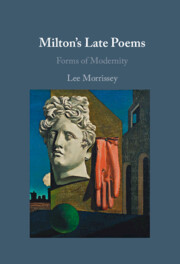Conclusion
“The Modern Paradox”: Temporal Forms of Modernity
Published online by Cambridge University Press: 18 August 2022
Summary
Milton’s late poems suggest that the best way to represent the experience of modernity is to turn to and to reimagine the work of the Ancients—the modern paradox. This raises questions of periodization, and time. Milton is more “Renaissance” than “early modern,” at least in terms of how the early modern is usually understood, i.e., as a temporally delimited historical period after the medieval and before Enlightenment modernity. The Renaissance was modernizing in its appropriation of the Ancients. Milton’s late poems are obsessed with temporality—well, temporalities, plural, actually—since Paradise Lost, Paradise Regained and Samson Agonistes narrate three different temporalities. Paradise Lost narrates the continual backwards and forwards of living in history—a present affected by the past, and by anticipatory imaginings of an as-yet unrealized future. Paradise Regained stays in the present, bringing readers along in a story that moves from a beginning to an end. In Samson Agonistes, Samson sees no future. The key subsequent literary development in verbally representing forms of modernity, the novel has a deep presentism which persists. Milton is received in a literary-critical tradition deeply affected by the novel’s focus on the present and on the synchronous life of the characters.
Keywords
- Type
- Chapter
- Information
- Milton's Late PoemsForms of Modernity, pp. 148 - 163Publisher: Cambridge University PressPrint publication year: 2022

